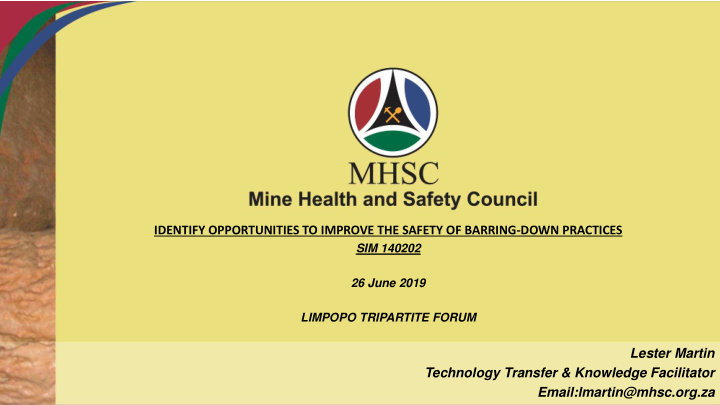



IDENTIFY OPPORTUNITIES TO IMPROVE THE SAFETY OF BARRING-DOWN PRACTICES SIM 140202 26 June 2019 LIMPOPO TRIPARTITE FORUM Lester Martin Technology Transfer & Knowledge Facilitator Email:lmartin@mhsc.org.za
Presentation Outline 1. MHSC Mandate 2. Project (Study): 1. Background of the Study 2. Objectives of the study 3. Methodology 4. Results of the Study 5. Conclusion 6. Recommendations 2
MHSC mandate MHSC is a national public entity established in terms of the MHSA, No 29 of 1996. Advise the Minister of Oversee OHS Mineral Zer Harm research Resources Review and Promote develop health and legislation safety culture (regulations) 5
Project SIM 140202 The purpose of the study was to IDENTIFY OPPORTUNITIES TO IMPROVE THE SAFETY OF BARRING DOWN PRACTICES for the commodities of gold, platinum and coal. Research Agency: Golder Associates Africa(PTY)Ltd. Authors: A Boodoo, CA Jermy, V Kuppusamy and P Ramsaroop Approx Completion Date: July 2016
What is Barring Barring is the removal of loose slabs of rock from roofs and walls of excavations. This is done to remove the fall of ground hazard posed by these loose blocks of rock. Barring may be performed manually with a steel or aluminium pinch bar which are the most locally used materials, or by using a mechanical barring machine such as a scaler. Project SIM 140202
Back Ground This study stemmed from the number of preventable rock related accidents that led to fatalities over a two and a half year period in South African Mines. Between 2009 to May 2011, 94 fatalities occurred. From the Provisional Statistics from the DMR
Objectives of the Study The objectives of this study were to report on root cause analysis of barring-down related accidents and incidents in the Platinum, Gold and Coal commodities. Other research outcomes included: 1. the identification of leading practices and the recommendation of feasible implementation solutions, 2. the assessment of barring training material, and 3. the development of barring training material.
Methodology 1. Obtaining 1. copies of barring related accidents from the regional DMR offices and from the champion mines 2. barring standards, COPs and training material from the champion mines 2. Observing and undergoing 1. barring and strata control training, on surface, in mock-ups and underground 2. barring in the underground environment in a range of mining environments 3. Interviewing mine personnel underground post barring activities to ascertain barring knowledge and competence 4. Social data collection on surface with focus group discussions and key informant interviews 5. Completing Root cause analyses 6. The assessment of barring training material, and 7. The development of an innovative barring training product in conjunction with Simulated Training Solutions (STS3D).
Results of the Study 1. The root causes were found to be predominantly related to human behaviour factors 2. These were inadequate leadership, inadequate training, and poor habits or personal preference. 3. Results from the social study highlighted worker attitudes, incorrect barring procedures, training systems and lack of appropriate leadership as key issues 4. Generally, worker attitudes reflect an unmotivated, unsupervised, non-compliant and dissatisfied workforce across all
Results of the Study A lack of appropriate knowledge and experience when undertaking barring. The most frequent reported worker attitude is complacency on the job where workers grow accustomed to the environment and job tasks that they are not vigilant when working in potential risk areas. Workers have expressed that they are overworked, stressed and fatigued which leads to lack of concentration and incorrect barring which increase the risk of incidents and injuries.
Results of the Study The following general comments can be made in respect to barring training practices: a) Barring is physical task and therefore requires a significant practical component. b) Barring rules should be unambiguous to prevent the misinterpretation by mine workers . c) More emphasis should be placed on the occupational health and safety hazards of the individual related to barring. E.g. Good posture. d) Behaviour that is unsafe and safe should be included in the theoretical and practical components and re-iterated frequently. Essentially incorporate corrective behaviour techniques in barring training. e) Transportation of the pinch bar and correct storage isn‟t always incorporated in the barring training. f) The training methods employed do not satisfy all the critical cross field outcomes mentioned in the standard. Efforts need to be made to include them.
Conclusion Training is an expensive undertaking and ineffective barring training practices are even more so hence the need for continual improvement of training practices. The reasons for technological advancements that assist with barring not being adopted The three areas suggested for improvement from the social Leadership, by: Employee Behaviour, by: Training Material, by:
Recommendations The wide distribution and usage of the barring training product is recommended. Future project considerations that arose from this research include: 1. Further research into human behaviour studies (psychology of underground employees) 2. Further research and design of Entry examination LED lights in collaboration with manufacturers and suppliers. 3. Adoption of CSIR and/or UP Integrated Thermal Acoustic (ITA) Devices 4. Further research into non-compliance to MOSH initiatives, and the reasons why 5. Social studies per mine investigating mine specific themes 6. Ergonomics of tasks underground
Project Journey Conti… 4
Training Material
Barring Training Videos are available 1. Introduction 2. Hazard Identification 3. 5 Ps to safe barring 4. Tricks of the Trade 5. Lesson learned and short cuts 6. Positive leadership.
Thank you for your attention Questions? 27
Recommend
More recommend